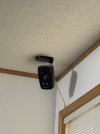This is a review and detailed measurements of the RSL C34E MKII architectural, home theater speaker. I purchased it for testing and costs US $149.
View attachment 314168
Please excuse the stock picture. Speaker is still on an ugly baffle on Klippel NFS. As this type of speaker goes, the C34E MKII is lighter than others I have tested. Instead of one large and heavy woofer, two smaller mid-woofers are deployed at an angle. I was not a fan of the rotating tabs in the back as they did not extend past the edge of the rim. This means if you cut your hole a bit too big, they won't bite. There is a diagram that I think shows you can rotate them but I did not mess with that.
